

|
| ESPAÑA | Spain |
| Castilla y León | Castile and León |
| Provincia: Segovia | Segovia |
Segovia is situated at an elevation of 1,005 m in the plains of Old Castile, near Valladolid and Madrid. It is the capital of the province Segovia, one of nine provinces that make up the autonomous community of Castile and León. Together with Ávila and Toledo, Sevilla counts as one of the three historic metropoles in the vicinity of Madrid. The municipality has a population of about 52,700 (2015). In 1985 the old city of Segovia and its famous Roman aqueduct (see below) were declared World Heritage Sites by UNESCO. The old city contains a multitude of historic buildings both civil and religious, including a large number of buildings of Jewish origin, notably within the old Jewish Quarter.
The name of Segovia is of Celtiberian origin (Segobriga). The 'modern' name, Segovia, was introduced by the Romans and is documented in Greek (Σεγουβια) and Arabic (شقوبؾة, Šiqūbiyyah) sources of the time. It is believed that the city was abandoned after the Islamic invasion of Spain centuries later. After the conquest of Toledo by Alfonso VI of León and Castile in 1085, Segovia was resettled. Segovia's position on trading routes made it an important centre of trade in wool and textiles. From the 13th until the 15th century, Segovia was a royal residence. Several splendid works of Gothic architecture were also completed during this period. Isabel I was proclaimed queen of Castile in the church of San Miguel de Segovia on 13 December 1474. After a decline in the 17th century, several, mostly unsuccessful, attempts were made to revitalise Segovia's textile industry. In 1764, the Royal School of Artillery, the first military academy in Spain, was opened. This academy remains present in the city today. During the nineteenth and first half of the twentieth century, Segovia experienced a demographic recovery that was the result of relative economic stability.
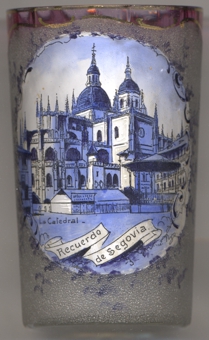
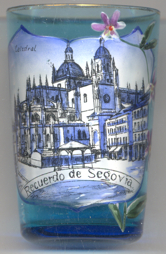
The  Catedral de Santa María de Segovia [left, no. 4018, and right, no. 3034]
is the last Gothic cathedral built in Spain. It is considered to be a masterpiece of
Basque-Castilian Gothic and is known as La Dama de las Catedrales.
It is the third cathedral church of the city and and includes the cloister of its precursor church that was destroyed
in 1520. The cathedral was built in 1525–1577 by order of Emperor Karl V. It is 105 metres long and 50 metres wide,
the nave has a height of 33 metres. The cupola above the intersection, which spans a width of 67 metres,
and the church tower with its height of 88 metres, in their present form, date from the 17th century.
Catedral de Santa María de Segovia [left, no. 4018, and right, no. 3034]
is the last Gothic cathedral built in Spain. It is considered to be a masterpiece of
Basque-Castilian Gothic and is known as La Dama de las Catedrales.
It is the third cathedral church of the city and and includes the cloister of its precursor church that was destroyed
in 1520. The cathedral was built in 1525–1577 by order of Emperor Karl V. It is 105 metres long and 50 metres wide,
the nave has a height of 33 metres. The cupola above the intersection, which spans a width of 67 metres,
and the church tower with its height of 88 metres, in their present form, date from the 17th century.
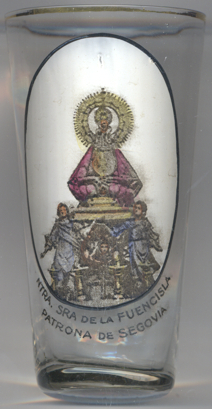
 La Virgen de la Fuencisla (Our Lady of the Fuencisla) is the patron saint of Segovia.
According to the legend, the image, sculptured by Saint Luke the Evangelist, was brought to the city by Saint Jeroteo,
according to legend first bishop of Segovia. The statue is venerated in the Santuario de Nuestra Señora de la Fuencisla;
her feast day is 25 September.
La Virgen de la Fuencisla (Our Lady of the Fuencisla) is the patron saint of Segovia.
According to the legend, the image, sculptured by Saint Luke the Evangelist, was brought to the city by Saint Jeroteo,
according to legend first bishop of Segovia. The statue is venerated in the Santuario de Nuestra Señora de la Fuencisla;
her feast day is 25 September.
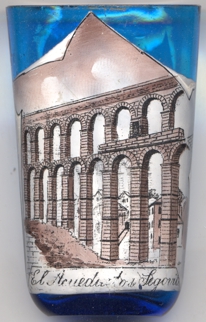
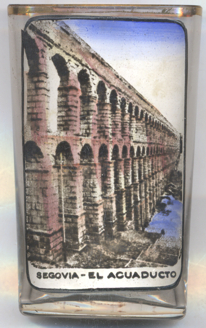
The  Aqueduct of Segovia is one of the best-preserved elevated Roman aqueducts. It is the
foremost symbol of Segovia, as evidenced by its presence on the city's coat of arms. As the aqueduct lacks a legible
inscription (one was apparently located in the structure's attic, or top portion), the date of construction cannot be
definitively determined. The general date of the Aqueduct's construction was long a mystery although it was thought to
have been during the 1st century AD. At the end of the 20th century, the text on the dedication plaque was deciphered by
studying the anchors that held the now missing bronze letters in place. It was determined that Emperor Domitian
(AD 81–96) ordered its construction and the year 98 was proposed as the most likely date of completion. However,
in 2016 evidence was published which points out to a slightly later date, by 112 AD.
Aqueduct of Segovia is one of the best-preserved elevated Roman aqueducts. It is the
foremost symbol of Segovia, as evidenced by its presence on the city's coat of arms. As the aqueduct lacks a legible
inscription (one was apparently located in the structure's attic, or top portion), the date of construction cannot be
definitively determined. The general date of the Aqueduct's construction was long a mystery although it was thought to
have been during the 1st century AD. At the end of the 20th century, the text on the dedication plaque was deciphered by
studying the anchors that held the now missing bronze letters in place. It was determined that Emperor Domitian
(AD 81–96) ordered its construction and the year 98 was proposed as the most likely date of completion. However,
in 2016 evidence was published which points out to a slightly later date, by 112 AD.

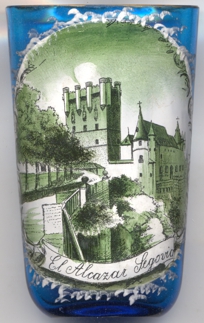
Rising out on a rocky crag above the confluence of two rivers, the Eresma and the Arroyo Clamores, the
 Alcázar
Alcázar

[https://en.wikipedia.org/wiki/Segovia, https://de.wikipedia.org/wiki/Segovia, https://es.wikipedia.org/wiki/Segovia;
https://es.wikipedia.org/wiki/Virgen_de_la_Fuencisla; https://en.wikipedia.org/wiki/Aqueduct_of_Segovia;
https://en.wikipedia.org/wiki/Alc%C3%A1zar_of_Segovia]
![[scale]](lineal.jpg)